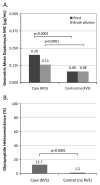Prior vancomycin use is a risk factor for reduced vancomycin susceptibility in methicillin-susceptible but not methicillin-resistant Staphylococcus aureus bacteremia
- PMID: 22227985
- PMCID: PMC3983274
- DOI: 10.1086/663708
Prior vancomycin use is a risk factor for reduced vancomycin susceptibility in methicillin-susceptible but not methicillin-resistant Staphylococcus aureus bacteremia
Abstract
Objective: Staphylococcus aureus is a cause of community- and healthcare-acquired infections and is associated with substantial morbidity, mortality, and costs. Vancomycin minimum inhibitory concentrations (MICs) among S. aureus have increased, and reduced vancomycin susceptibility (RVS) may be associated with treatment failure. We aimed to identify clinical risk factors for RVS in S. aureus bacteremia.
Design: Case-control.
Setting: Academic tertiary care medical center and affiliated urban community hospital.
Patients: Cases were patients with RVS S. aureus isolates (defined as vancomycin E-test MIC >1.0 μg/mL). Controls were patients with non-RVS S. aureus isolates.
Results: Of 392 subjects, 134 (34.2%) had RVS. Fifty-eight of 202 patients (28.7%) with methicillin-susceptible S. aureus (MSSA) isolates had RVS, and 76 of 190 patients (40.0%) with methicillin-resistant S. aureus (MRSA) isolates had RVS (P = .02). In unadjusted analyses, prior vancomycin use was associated with RVS (odds ratio [OR], 2.08; 95% confidence interval [CI], 1.00-4.32; P = .046). In stratified analyses, there was significant effect modification by methicillin susceptibility on the association between vancomycin use and RVS (P =.04). In multivariable analyses, after hospital of admission and prior levofloxacin use were controlled for, the association between vancomycin use and RVS was significant for patients with MSSA infection (adjusted OR, 4.02; 95% CI, 1.11-14.50) but not MRSA infection (adjusted OR, 0.87; 95% CI, 0.36-2.13).
Conclusions: A substantial proportion of patients with S. aureus bacteremia had RVS. The association between prior vancomycin use and RVS was significant for patients with MSSA infection but not MRSA infection, suggesting a complex relationship between the clinical and molecular epidemiology of RVS in S. aureus.
Conflict of interest statement
Figures

Similar articles
-
Reduced Vancomycin Susceptibility, MRSA and Treatment Failure in Pediatric Staphylococcus aureus Bloodstream Infections.Pediatr Infect Dis J. 2021 May 1;40(5):429-433. doi: 10.1097/INF.0000000000002992. Pediatr Infect Dis J. 2021. PMID: 33196562 Free PMC article.
-
Reduced Vancomycin Susceptibility of Methicillin-Susceptible Staphylococcus aureus Has No Significant Impact on Mortality but Results in an Increase in Complicated Infection.Antimicrob Agents Chemother. 2017 Jun 27;61(7):e00316-17. doi: 10.1128/AAC.00316-17. Print 2017 Jul. Antimicrob Agents Chemother. 2017. PMID: 28507105 Free PMC article.
-
Vancomycin MICs and risk of complicated bacteremia by glycopeptide-susceptible Staphylococcus aureus.Eur J Clin Microbiol Infect Dis. 2019 May;38(5):903-912. doi: 10.1007/s10096-019-03500-7. Epub 2019 Feb 6. Eur J Clin Microbiol Infect Dis. 2019. PMID: 30729396
-
Bacteremia due to Methicillin-Resistant Staphylococcus aureus: An Update on New Therapeutic Approaches.Infect Dis Clin North Am. 2020 Dec;34(4):849-861. doi: 10.1016/j.idc.2020.04.003. Epub 2020 Sep 30. Infect Dis Clin North Am. 2020. PMID: 33011050 Review.
-
Treatment of bacteraemia: meticillin-resistant Staphylococcus aureus (MRSA) to vancomycin-resistant S. aureus (VRSA).Int J Antimicrob Agents. 2013 Jun;42 Suppl:S17-21. doi: 10.1016/j.ijantimicag.2013.04.006. Epub 2013 May 8. Int J Antimicrob Agents. 2013. PMID: 23664580 Review.
Cited by
-
Derivation and validation of clinical prediction rules for reduced vancomycin susceptibility in Staphylococcus aureus bacteraemia.Epidemiol Infect. 2013 Jan;141(1):165-73. doi: 10.1017/S0950268812000295. Epub 2012 Apr 10. Epidemiol Infect. 2013. PMID: 22490228 Free PMC article.
-
Effects of vancomycin versus nafcillin in enhancing killing of methicillin-susceptible Staphylococcus aureus causing bacteremia by human cathelicidin LL-37.Eur J Clin Microbiol Infect Dis. 2016 Sep;35(9):1441-7. doi: 10.1007/s10096-016-2682-0. Epub 2016 May 27. Eur J Clin Microbiol Infect Dis. 2016. PMID: 27234592 Free PMC article.
-
Reduced vancomycin susceptibility and staphylococcal cassette chromosome mec (SCCmec) type distribution in methicillin-resistant Staphylococcus aureus bacteraemia.J Antimicrob Chemother. 2012 Oct;67(10):2346-9. doi: 10.1093/jac/dks255. Epub 2012 Jul 3. J Antimicrob Chemother. 2012. PMID: 22761330 Free PMC article.
-
Impact of Time to Appropriate Therapy on Mortality in Patients with Vancomycin-Intermediate Staphylococcus aureus Infection.Antimicrob Agents Chemother. 2016 Aug 22;60(9):5546-53. doi: 10.1128/AAC.00925-16. Print 2016 Sep. Antimicrob Agents Chemother. 2016. PMID: 27401565 Free PMC article.
-
Nasal microbiota predictors for methicillin resistant Staphylococcus colonization in critically ill children.PLoS One. 2025 Jan 15;20(1):e0316460. doi: 10.1371/journal.pone.0316460. eCollection 2025. PLoS One. 2025. PMID: 39813207 Free PMC article.
References
-
- Cosgrove SE, Qi Y, Kaye KS, Harbarth S, Karchmer AW, Carmeli Y. The impact of methicillin resistance in Staphylococcus aureus bacteremia on patient outcomes: mortality, length of stay, and hospital charges. Infect Control Hosp Epidemiol. 2005;26(2):166–174. - PubMed
-
- McDonald LC. Trends in antimicrobial resistance in health care-associated pathogens and effect on treatment. Clin Infect Dis. 2006;42(suppl 2):S65–S71. - PubMed
-
- Kollef MH. Limitations of vancomycin in the management of resistant staphylococcal infections. Clin Infect Dis. 2007;45(suppl 3):S191–S195. - PubMed
-
- Steinkraus G, White R, Friedrich L. Vancomycin MIC creep in non-vancomycin-intermediate Staphylococcus aureus (VISA), vancomycin-susceptible clinical methicillin-resistant S. aureus (MRSA) blood isolates from 2001–05. J Antimicrob Chemother. 2007;60(4):788–794. - PubMed
Publication types
MeSH terms
Substances
Grants and funding
LinkOut - more resources
Full Text Sources
Other Literature Sources
Medical
